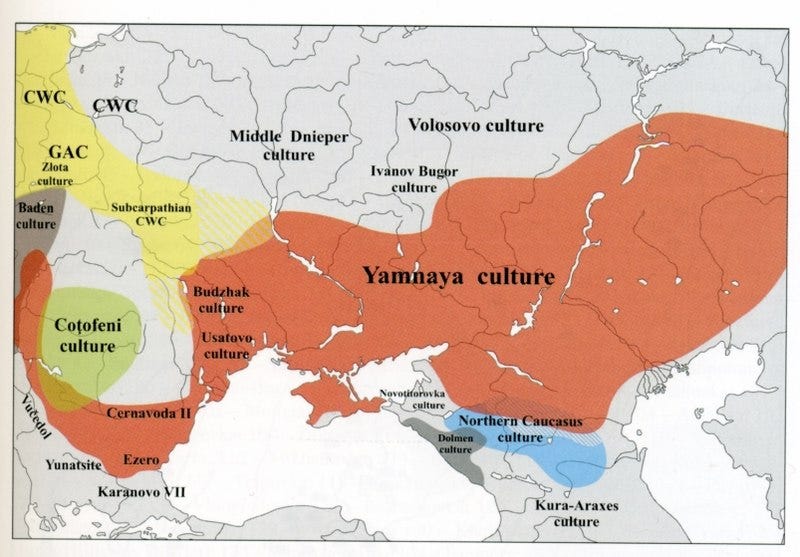Milk's Role in Shaping Human History During the Bronze Age
Written on
Chapter 1: The Significance of Dairy in Human Evolution
Milk and dairy have become staples in our modern diets, but their role in human evolution is relatively recent. Historically, lactose intolerance was prevalent, as humans could not digest milk until genetic mutations allowed for this adaptation. This transformation marked a pivotal moment in our evolutionary journey.
The Yamnaya, an ancient culture that thrived over 5,000 years ago across the Eurasian Steppes, exemplifies the evolutionary leap facilitated by milk. This group, fueled by dairy, migrated from the Pontic Steppes—present-day Ukraine and Russia—reaching as far as Britain and Mongolia.
Milk was essentially the superfood of the Bronze Age, serving as a primary energy source packed with essential nutrients that helped the Yamnaya navigate challenging environments. Before delving deeper into the pivotal role of milk, let's first examine the fascinating culture of the Yamnaya and their historical significance.
Section 1.1: Who Were the Yamnaya?
The Yamnaya civilization, dating from 3300 BC to 2600 BC, flourished in the Pontic Steppes, a region situated north of the Black Sea and Caspian Sea. The name "Yamnaya" originates from the Russian term "Yamna Kul’tura," meaning "pit culture," reflecting their distinctive burial practices.
Unlike their Neolithic predecessors, who typically utilized communal graves, the Yamnaya buried their dead in individual pits, often accompanied by personal items like jewelry and weapons. These burial mounds, known as kurgans, are key archaeological markers of the Yamnaya culture.
The Yamnaya were technologically advanced for their time, possessing skills in bronze crafting, horse domestication, and wheeled transportation. This raises intriguing questions about their origins and the factors that propelled their society ahead of others in Europe.
Subsection 1.1.1: The Genetic Makeup of the Yamnaya

Genetic research indicates that the Yamnaya were a blend of Eastern European and Caucasian hunter-gatherers, supplemented by approximately 18% DNA from early European farmers. This unique genetic mixture contributed to the Yamnaya's stratified social structure, although scholars debate the specifics of their societal organization.
Primarily pastoral nomads, the Yamnaya relied on animal husbandry rather than agriculture as their main food source. The steppe's geography, rich in forage but poor in cultivable land, necessitated a diet reliant on animal products, including meat, cheese, and yogurt.
The migrations of the Yamnaya across Eurasia mark a significant turning point in history. They are believed to be the ancestors of the Indo-European language family, introducing many of the languages still spoken across Europe and parts of Asia today.
Chapter 2: The Role of Dairy in Yamnaya Migrations
In September 2021, researchers from Harvard University and the Max Planck Institute published a groundbreaking study examining the dental remains of ancient populations. By analyzing tartar from the teeth of pre-Bronze Age individuals in contrast to those from the Yamnaya culture, they found that while pre-Bronze Age samples showed no evidence of milk consumption, a staggering 94% of Yamnaya samples did.
This finding coincides with the timing of the Yamnaya's migrations and suggests a remarkable shift in dietary practices. The researchers hypothesized that the Yamnaya likely fermented milk to make it more digestible, leading to the consumption of yogurt and cheese—forms of dairy easier on the digestive system.
The first video, "Ancient DNA study shows milk consumption increased human body size: Jay Stock, Western Anthropology," provides insights into how milk consumption may have influenced human development.
The Yamnaya's ability to consume milk from various animals, including cows, sheep, goats, and horses, granted them a significant advantage for long-distance migrations. Milk not only ensured hydration in arid regions but also contributed to their overall health and technological progress.
Section 2.1: Impact of Yamnaya Migrations on Europe
Men predominantly led the Yamnaya migrations, intermingling with women from declining Neolithic cultures, which resulted in the emergence of new cultural identities such as the Corded Ware culture in Central Europe and the Bell Beaker culture in Britain.
Initially, it was believed that Yamnaya warriors mounted on horses invaded Europe, but this theory has been largely discredited. Instead, evidence indicates that the farming communities of Europe were already in decline, facing little resistance from the Yamnaya.
Could the Yamnaya have been a factor in the collapse of Neolithic societies? Several clues suggest this possibility. The Yamnaya's male-to-female ratio of 14:1 implies a warrior class, and their technological advancements gave them a significant edge over less developed populations.
Additionally, some researchers propose that the Yamnaya may have inadvertently spread diseases, contributing to the decline of Neolithic farming communities, although this theory lacks strong scientific consensus due to the interbreeding between the Yamnaya and local populations.
The second video, "Bronze Age Massacre Reveals Uncomfortable Questions about the Genes that allow us to Drink Milk!" delves into the genetic adaptations that enabled the Yamnaya to thrive in their environment.
Ultimately, the Yamnaya's ability to digest milk, facilitated by genetic mutations for lactase persistence, was pivotal for their survival and success. The exact timeline and mechanisms of these adaptations remain subjects of ongoing research.
In conclusion, the Yamnaya played a crucial role in shaping not only the linguistic landscape of Europe but also the genetic and cultural tapestry of the continent. Their legacy continues to influence modern societies, leaving us with many questions about our shared history and the origins of language.